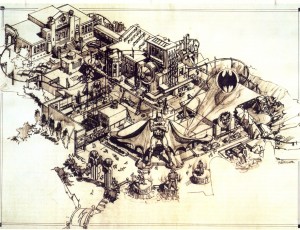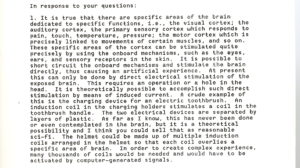Part 7 of a continuing series examining the original proposal for Universal Studios Florida’s Islands of Adventure theme park.
By now you probably think you’ve heard it all when it comes to Batman and his dance with the powers that be at Universal Studios Florida (but not to be confused with The Batdance by Prince — that’s something else entirely). There has been everything you’d expect from a theme-park proposal, from shops and restaurants to rides and shows. Everything a Dark Knight needs to entertain the millions of people who look up to him as a defender of justice and long to spend some time exploring his world and participating in his adventures. But you’ve never seen anything like what they had in mind for ol’ Batsy back in 1992.
The creative forces charged with creating this Batman theme-park proposal approached a neurologist and inquired about the feasibility of an attraction that was truly “virtual reality.” The attraction in question is the “Justice League: Mindwarp” attraction. In this proposed attraction you’ll enter into the actual Hall of Justice, home of the legendary Justice League of America (the fact that they were planning on building this particular structure is fantastic — as a fan of the Super Powers action figure collection by Kenner in the 1980s, the Hall of Justice playset was the centerpiece of the set. Hopefully they would have omitted the Justice Jogger vehicle — and if you know what this is, congratulations: you’ve earned your geek wings just like me).
Inside the Hall of Justice you’ll file past giant statues of Superman, Batman, Wonder Woman, the Flash and the Green Arrow and into a circular chamber to meet “The Keeper,” an alien guardian who is charged with taking care of the Hall of Justice. There’s no mention to where the character came from but “The Keeper” is a scientist of sorts and he has a new invention he wants to share with everyone. It’s the Justice League Mindwarp device and it will allow you to experience firsthand the daring and courageous exploits of the heroes of the Justice League. (This entire scenario comes from the idea that the Hall of Justice is less a headquarters for the Justice League and more of a museum that allows members of the public to see exhibits from past deeds and reminders of the constant evil the world faces. With so many children having grown up on the Superfriends cartoon series it may have been confusing to find the Hall of Justice a museum and not a fully functioning base of operations).
“The Keeper” shows everyone the Mindwarp device –it’s a futuristic looking piece of headgear consisting of a headband with small holophonic (their word, not mine) speakers angled into the ears for stereo sound and wrap-around liquid crystal 3-D glasses. Once you enter the theatre and put the glasses on you’ll experience the most realistic virtual reality show the world has ever seen with sights, sounds, scents and tactile responses recreated to make you feel as if you are really a part of the action.
There’s no real indication as to what the actual show would have entailed but those who are even marginally aware of the Justice League can imagine what a “best of” compendium of their greatest hits would have been like! Eventually this idea was scrapped but from the notes I can ascertain that originally this show had some lofty goals. The inquiry made to the neurosurgeon asks in detail how realistic it would be to stimulate certain parts of the brain to create false assumptions in the body and/or central nervous system.
(This is huge! The designers were really asking how to create a mind-altering experience at a theme park! A real “mess with your head” attraction that fools your brain into believing that the projected images and sounds are completely real! Now this is a blue-sky concept — and had the powers that be decided to pump millions into it … well, who knows how far they would have gotten).
There have already been attractions built with subtle effects to fool your brain, although nothing nearly as elaborate or reaching as the Mindwarp proposal. Some existing theme park examples include:
• Kongfrontation at Universal Studios — opened in both Hollywood and Florida. It was considered one of the premiere attractions in Florida. This attraction used banana scent to enhance the attraction and add another layer to convince you that the giant ape was real. This is probably the earliest and most well-known use of scent in a theme-park attraction.
• Soarin’ Over California at Disney’s California Adventure (simply “Soarin'” at Epcot) –a groundbreaking attraction with virtually no real storyline that takes guests on an aerial journey through the Golden State. This time the scent of oranges is employed to convince riders that the projected orange groves were real.
• Indiana Jones and the Temple of the Forbidden Eye at Disneyland –this mega attraction uses forward traveling walls that give the illusion of movement when the ride vehicle itself is stationary. There are some other noteworthy effects in this attraction such as the rat projection on smoke and popping air effects to simulate both bugs and flying arrows.
• The ExtraTERRORestial Alien Encounter (Eventually shortened to Alien Encounter and finally transformed into Stitch’s Great Escape) at Walt Disney World –features many tricks to fool the brain into believing an alien has escaped into the theatre. Sound, water and air are used to simulate the alien’s movements, breath and tongue as it licks you!
The Mindwarp inquiry directly asks if it is possible to beam the attraction directly into the brain (think the Riddler’s blender contraption from Batman Forever and you’ll get the idea. That particular idea hits theatre screens in 1995 just a stone’s throw from this proposal’s date of 1992 –coincidence?).
This is certainly new ground for a theme-park attraction. Beaming an attraction directly into the brain of a theme-park guest? Why stop there? Why not beam ads and wants and desires for additional products and experiences? As Bruce Wayne himself says, “It raises too many questions.” But alas, the technology of 1992 was not sufficient enough to accomplish any of the proposal’s ideas. The neurosurgeon responds with this excerpt:
“It is true that there are specific areas of the brain dedicated to specific functions, i.e., the visual cortex, the auditory cortex, the primary sensory cortex which responds to pain, touch, temperature, pressure; the motor cortex which is precisely linked to movements of certain muscles, and so on. These specific areas of the cortex can be stimulated quite precisely by using the onboard mechanisms, such as the eyes, ears and sensory receptors in the skin. It is possible to short circuit the onboard mechanisms and stimulate the brain directly, thus causing an artificial experience. At present this can only be done by direct electrical stimulation of the exposed brain. This requires and operation or a hole in the head. It is theoretically possible to accomplish such direct stimulation by means of induced current. A crude example of this is the charging device for an electric toothbrush. An induction coil in the charging holders stimulates a coil in the toothbrush handle. The two electrical devices are separated by layers of plastic. As far as I know, this had never been done or even contemplated in the brain, but it is a theoretical possibility and I think you could sell that as reasonable sci-fi. The helmet could be made of multiple induction coils arranged in the helmet so that each coil overlies a specific area of the brain. In order to create complex experience many thousands of coils would be needed and would have to be activated by computer-generated signals.”
As you can read, the good doctor says that such an attraction is just not feasible since to even begin to fool the brain into believing that a fake experience is in fact real requires an entry point in the head. Yes, you need this attraction as much as you need a hole in your head, ladies and gentlemen.
Still, it’s a fascinating insight into how theme-park attractions are created, the work that goes into devising new experiences and the limbs on which some people will go out to grasp that new and exciting concept in the hope that it will mesmerize millions of people. I wish there was more to the Mindwarp proposal so that I could share what exactly those grand superhero adventures would have been. Sadly, there is hardly any mention of this lost attraction in the proposal and this strange inquiry into the powers of the brain only serve to pique my curiosity even further. As I mentioned earlier, the Batman Forever connection is hard to ignore and after a recent viewing of that film one wonders how close we are this many years later to unlocking the potential of beaming attractions directly into the brain. I hope you enjoyed this brief detour on our journey through the never-before-seen Batman Island proposal –next time we’ll take a seat in a grand arena and check out the proposal for the biggest theme-park show ever conceived –it’s gonna make House Party look like House Party 2!
Jeff Tucker works in the theme park industry. His magical book series, “The Sixth Key,” is available on Amazon.com. He also hosts his own Podcast, “91 Reasons,” available on iTunes.





Comments are closed.